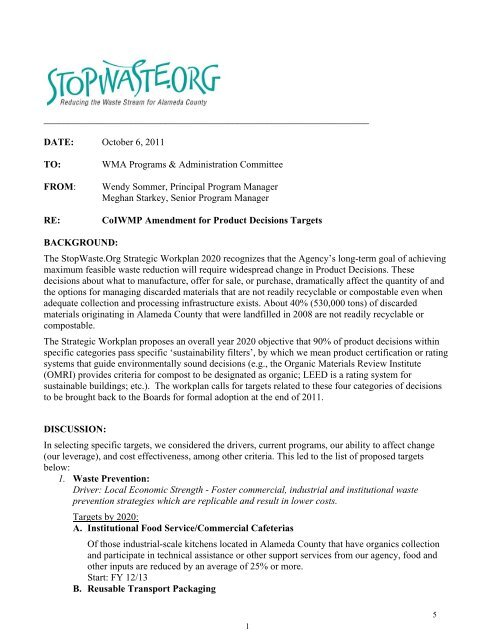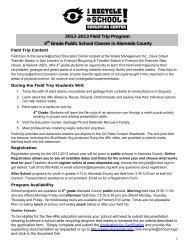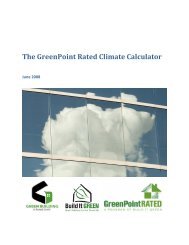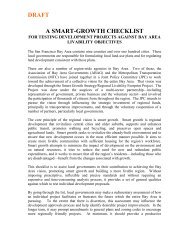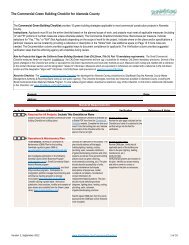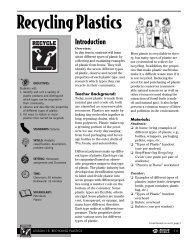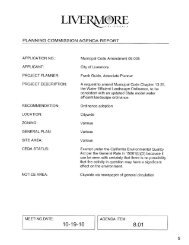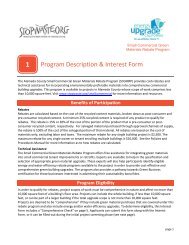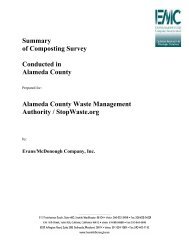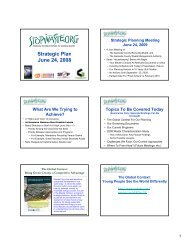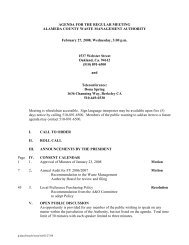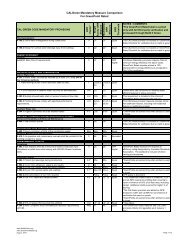October 6, 2011 TO - StopWaste.Org
October 6, 2011 TO - StopWaste.Org
October 6, 2011 TO - StopWaste.Org
You also want an ePaper? Increase the reach of your titles
YUMPU automatically turns print PDFs into web optimized ePapers that Google loves.
(h) The Authority provided all required notice and held a duly noticed public hearing on<strong>October</strong> 26, <strong>2011</strong>, to consider this CoIWMP amendment.SECTION 3 (Amendment of CoIWMP)The Authority does hereby adopt the amendments to the CoIWMP as set forth in Exhibit 1 and made apart of this ordinance.SECTION 4 (Notice and Effective Date)The Clerk of the Board shall have a summary of this Ordinance published twice in a newspaperof general circulation, once 5 days before its adoption and again within 15 days after adoption. ThisOrdinance shall also be posted at the Authority Office for at least thirty (30) days after adoption.This Ordinance shall become effective thirty (30) days after adoption.This Ordinance was introduced at the ___________, meeting of the Board and was adopted atthe regular Board meeting of __________, by the following vote:AYES:NOES:ABSTAINING:ABSENT:I certify that under penalty of perjury that the foregoing is a full, true and correct copy of ORDINANCENO. <strong>2011</strong> - ___.Gary Wolff, P.E., Ph.D.Executive DirectorExhibit 1:CoIWMP Amendment Text610
10-4-<strong>2011</strong>years. The Alameda County LEA reviews its Facility Permits every five years. Inaddition, a review may be triggered when an project owner applies for a permitrevision.The Authority may directly enforce its own facility related policies and ordinances, suchas the countywide plant debris landfill ban, or indirectly enforce through designatedparties when authorized in its policies and ordinances.OBJECTIVE 1.2:Policy 1.2.1:Policy 1.2.2:Policy 1.2.3:Policy 1.2.4:Policy 1.2.5:Policy 1.2.6:To the greatest extent feasible, proposed new or expanded solid wastefacilities have no significant adverse health, safety or environmentalimpacts.All proposals shall be thoroughly evaluated as to their health,safety and environmental impacts; alternatives and mitigationmeasures shall be considered.All significant negative impacts shall be mitigated to the maximumextent feasible. Use of override findings should be avoided exceptwhere the benefits of the project outweigh other considerations.Compliance with all other regulatory requirements shall berequired.All adopted mitigation measures shall be monitored and enforcedin accord with an approved mitigation monitoring program.To the extent that the Authority supports facilities outside of itsjurisdiction, it will take action to mitigate environmental impacts,including air pollution impacts.The Authority will consider proximity to source of generation as apriority for facility location.The Authority will encourage use of clean air vehicles for wasteand diversion transportation to reduce environmental impacts.Implementation (Objective 1.2, Policies 1.2.1-1.2.6):Health and safety impacts are evaluated through the local land use approval process, theCEQA process, Solid Waste Facilities Permit process, and the Authority CountyIntegrated Waste Management Plan [CoIWMP] conformance process. This Plan containsgeneralized siting criteria. Local jurisdictions may adopt more detailed and stringentcriteria. In addition to local approvals, health and safety impacts may be considered byother responsible regional, state and federal agencies.The CEQA environmental assessment and mitigation process is a primary means ofensuring that potential environmental impacts are adequately addressed. AlthoughCEQA does not require an analysis of fiscal impacts, such analyses can be added at thediscretion of the public agencies involved. Permitting agencies are required to adoptmitigation measures unless they are found to be infeasible and override findings areACMWA CoIWMP—Countywide Element V-213
10-4-<strong>2011</strong>Policy 1.4.2:Policy 1.4.3:Policy 1.4.4:Policy 1.4.5:Under general waste prevention, the Authority shall fostercommercial, industrial and institutional waste prevention strategieswhich are replicable and result in lower costs. (Mirrors Policy2.8.2)Under household hazardous waste prevention, the Authority shallpromote purchase of available and effective alternatives wheneverthey are comparably priced with HHW products (including endof-life management costs). (Mirrors Policy 1.3.3)Under recycled content products, the Authority shall supportdevelopment of demand for and supply of recycled contentproducts or feedstock that support green jobs in Alameda County.(Mirrors 2.8.4)Under hard to recycle or compost materials, the Authority shalldiscourage purchase of products that are hard to recycle, reuse orcompost unless there is some compelling reason to continue usingthem.Implementation (Objective 1.4, Policies 1.4.1-1.4.5):Initial targets to implement this objective are as follows:o Of those industrial scale kitchens located in Alameda County that have organicscollection and participate in technical assistance or other support services from theAuthority, reduce food and other inputs by an average of 25% or more.o 90% of businesses in Alameda County with appropriate shipping and receivingcircumstances are utilizing reusable transport packaging when economicallyadvantageous.o 90% of permitted landscape projects in Alameda County use locally produced orsourced compost.o 90% of permitted landscape projects in Alameda County use locally produced orsourced mulch.o 90% of building material supply centers will stock and promote recycled contentbuilding materials that support local green jobs.o 90% of customers (institutional and commercial) with separate organics collectionpurchase and use readily recyclable/reusable/compostable food service ware andpackaging.o 90% of Alameda County brand owner/manufacturers join the Sustainable PackagingCoalition (SPC) and use their life-cycle assessment (LCA) tool or other credible toolto compare the environmental impacts of their packaging designs and provide andpromote consumer packaged goods that are using the SPC’s Voluntary Recyclabilitylabel on their packaging.o 90% of stores that sell significant quantities of products destined for HHW facilitieswill stock and promote non-toxic/less-toxic HHW alternative products. (MirrorsImplementation of Objective 1.3, Policies 1.3.3-1.3.4)ACMWA CoIWMP—Countywide Element V-516
10-4-<strong>2011</strong>These policies and targets will be incorporated into Product Decisions program designand implementation. The Strategic Workplan (adopted July 2010) contains detail onprogrammatic implementation and will be updated annually as per Objective 5.5.Policy 1.4.6:Policy 1.4.7:Specific projects and measures to implement this objective wouldbe developed and implemented (through project screening) toensure that the Authority does not support programs withsignificant negative environmental impacts or those withsignificant financial impacts on member agency expenses. (MirrorsPolicies 1.3.5, 2.7.4 and 2.8.5)In support of this objective, the Authority shall adopt specific“sustainability filters,” meaning certification or rating systems thatguide environmentally sound decisions. (Mirrors Policies 1.3.6,2.7.5 and 2.8.6)Implementation (Objective 1.4, Policies 1.4.6-1.4.7):These policies will be incorporated into Product Decisions program design andimplementation. The Strategic Workplan (adopted July 2010) contains detail onprogrammatic implementation and will be updated annually as per Objective 5.5.ACMWA CoIWMP—Countywide Element V-617
10-4-<strong>2011</strong>OBJECTIVE 2.4:Policy 2.4.1:Policy 2.4.2:Policy 2.4.3:To reduce the amount of readily recyclable and compostablematerials deposited in landfills to no more than 10 percent of totalmaterials landfilled by 2020.The Authority shall implement waste management programs andfacilities that maximize recovery and reduce disposal of readilyrecyclable and compostable materials.The Authority shall monitor progress to this goal through directevaluation.The Authority shall also evaluate contaminants in source separatedrecycling and composting programs to ensure that pursuit of thisobjective does not substantially increase contaminants in thoseprograms.Implementation (Objective 2.4, Policies 2.4.1-2.4.3):The Agency shall incorporate these policies into Discard Management program designand implementation. The Strategic Workplan (adopted July 2010) contains detail onprogrammatic implementation and will be updated annually as per Objective 5.5.OBJECTIVE 2.5:Policy 2.5.1:Policy 2.5.2:Policy 2.5.3:To achieve by composting, an additional 425,000 tons of countywidediversion of organics per year by 2020.The Authority shall support composting programs where theproduct has a marketable use and where the product has otherbeneficial uses. The Authority shall also develop or support incountycomposting capacity for convenient economical diversionof organic materials.The Authority shall invest in composting facilities to expandcapacity, if necessary to achieve Plan objectives, subject to fundingavailability and Policy 5.2.2.The Authority shall act within its powers to ensure that additionaltransportation of organics to composting sites in support of thisobjective shall not cause exceedances of the current applicableCEQA screening thresholds of air districts for criteria air pollutantsand greenhouse gases.Implementation (Objective 2.5, Policies 2.5.1-2.5.3):To achieve the policies above, actions could include supporting in-county capacity for aminimum of 180,000 tons per year or other measures; and supporting facilities consistentwith policies 1.2.4, 1.2.5 and 1.2.6. Air emissions caused by transportation of organics tofacilities will be tracked as necessary to support Policy 2.5.3.ACMWA CoIWMP—Countywide Element V-920
10-4-<strong>2011</strong>OBJECTIVE 2.6:Policy 2.6.1:Policy 2.6.2:Policy 2.6.3:Policy 2.6.4:Avoid or limit waste reduction by technologies that convert waste intoenergy.The Authority shall support safe transformation for separatedmaterials, such as wood chips, if it is demonstrated that alternativemarkets for the material are not available.The CoIWMP shall not provide for "mass burn" waste-to-energyfacilities, unless potential environmental impacts, health risks,impacts to material recovery programs and financial risks are fullymitigated.For residual wastes that must be landfilled, the Authority shallsupport recovery of landfill gases and their use in the co-generationof energy.This policy shall not prevent projects that use only sourceseparated organics and create a soil amendment.Implementation (Objective 2.6, Policies 2.6.1-2.6.4):No transformation facilities are proposed. The Authority will consider facilities thatproduce fuel, such as wood chips, for transformation elsewhere. The Authority enforcesthis policy through the Plan Conformance process, selection of Countywide/ Sub-countyPrograms, and funding support to member agency programs. Further, incineration ofrefuse within the unincorporated area of Alameda County is prohibited under Measure D.Each landfill Solid Waste Facility Permit shall require the safe capture of landfill gasesand, where feasible, their recovery and use as alternative energy sources.OBJECTIVE 2.7:Policy 2.7.1:Policy 2.7.2:Policy 2.7.3:To strive to ensure that adequate markets or other beneficial uses areavailable for all materials recovered from the wastestream.The Authority shall promote market development for recycledmaterials and compost.The Authority shall promote contingency plans for recycledmaterials facilities and compost facilities in Alameda County.The Authority shall promote those products that have locallyharvested recyclable material content.Implementation (Objective 2.7, Policies 2.7.1-2.7.5):The Authority has prepared a countywide disaster waste management plan.Initial targets to implement this objective are as follows. (These targets mirror a subset ofthose in Implementation for Objective 1.4, Policies 1.4.1-1.4.5).ACMWA CoIWMP—Countywide Element V-1021
10-4-<strong>2011</strong>o 90% of permitted landscape projects in Alameda County use locally produced orsourced composto 90% of permitted landscape projects in Alameda County use locally produced orsourced mulch.o 90% of building material supply centers will stock and promote recycled contentbuilding materials that support local green jobs.The Agency shall incorporate these policies and targets into program design andimplementation. The Strategic Workplan (adopted July 2010) contains detail onprogrammatic implementation and will be updated annually as per Objective 5.5.Policy 2.7.4:Policy 2.7.5:Specific projects and measures to implement this objective wouldbe developed and implemented (through project screening) toensure that the Authority does not support programs withsignificant negative environmental impacts or those withsignificant impacts on member agency expenses. (Mirrors Policies1.3.5, 1.4.6 and 2.8.5)In support of this objective, the Authority shall adopt specific“sustainability filters,” meaning certification or rating systems thatguide environmentally sound decisions. (Mirrors Policies 1.3.6,1.4.7 and 2.8.6)Implementation (Objective 2.7, Policies 2.7.4-2.7.5):These policies will be incorporated into Product Decisions program design andimplementation. The Strategic Workplan (adopted July 2010) contains detail onprogrammatic implementation and will be updated annually as per Objective 5.5.OBJECTIVE 2.8:To use waste management facilities and programs as a means toincrease economic development.Policy 2.8.1:Policy 2.8.2:Policy 2.8.3:The Authority shall promote development of new private industryin Alameda county County that utilizes materials diverted from thelocal wastestream.The Authority shall foster commercial, industrial and institutionalwaste prevention strategies which are replicable and result in lowercosts. (Mirrors Policy 1.4.2)The Authority shall promote waste prevention activities to thecommercial, industrial and institutional sectors as a means ofbolstering local economic efficiency and supporting the localeconomy.ACMWA CoIWMP—Countywide Element V-1122
10-4-<strong>2011</strong>Policy 2.8.4:The Authority shall support demand for and supply of recycledcontent products or feedstock that supply green jobs in AlamedaCounty. (Mirrors Policy 1.4.4)Implementation (Objective 2.8, Policies 2.8.1-2.8.4):Initial targets to implement this objective are as follows. (These targets mirror a subset ofthose in Implementation for Objective 1.4, Policies 1.4.1-1.4.5):o Of those industrial scale kitchens located in Alameda County that have organicscollection and participate in technical assistance or other support services from theAuthority, reduce food and other inputs by an average of 25% or moreo 90% of businesses in Alameda County with appropriate shipping and receivingcircumstances are utilizing reusable transport packaging when economicallyadvantageouso 90% of permitted landscape projects in Alameda County use locally produced orsourced composto 90% of permitted landscape projects in Alameda County use locally produced orsourced mulch.o 90% of building material supply centers will stock and promote recycled contentbuilding materials that support local green jobs.The Authority will continue implementing or begin implementing, the followingprograms on a countywide or sub-regional basis to address Objectives 2.2., 2.3, 2.4, 2.5,2.7 and 2.8and policies 2.2.1, 2.3.1, 2.4.1 2.7.1 and 2.8.1. The Agency shall incorporatethese policies and targets into Product Decisions program design and implementation.The Strategic Workplan (adopted July 2010) contains detail on programmaticimplementation past 2010 and will be updated annually as per Objective 5.5.Policy 2.8.5:Policy 2.8.6:Specific projects and measures to implement this objective wouldbe developed and implemented (through project screening) toensure that the Authority does not support programs withsignificant negative environmental impacts or those withsignificant impacts on member agency expenses. (Mirrors Policies1.3.5, 1.4.6 and 2.7.4)In support of this objective, the Authority shall adopt specific“sustainability filters,” meaning certification or rating systems thatguide environmentally sound decisions. (Mirrors Policies 1.3.6,1.4.7 and 2.7.5)Implementation (Objective 2.8, Policies 2.8.5-2.8.6):ACMWA CoIWMP—Countywide Element V-1223
10-4-<strong>2011</strong>These policies will be incorporated into Product Decisions program design andimplementation. The Strategic Workplan (adopted July 2010) contains detail onprogrammatic implementation and will be updated annually as per Objective 5.5.[NOTE: IMPLEMENTATION DETAILS COVERING 2000 - 2010 (ORIGINALLYAPPEARING ON PAGES V-8-V-21) HAVE BEEN DELETED AND APPEAR ATTHE END OF THIS RED LINE DRAFT.]ACMWA CoIWMP—Countywide Element V-1324
10-4-<strong>2011</strong>GOAL 3: PROVIDE PUBLIC INFORMATION AND EDUCATIONTo build broad public support for the CoIWMP programs and their implementation.OBJECTIVE 3.1:Policy 3.1.1:Policy 3.1.2:OBJECTIVE 3.2:Policy 3.2.1:OBJECTIVE 3.3:Policy 3.3.1:OBJECTIVE 3.4:Policy 3.4.1:OBJECTIVE 3.5:To enhance the public awareness and understanding of wastemanagement issues in general.The Authority, in conjunction with member agency programs, shallencourage a focus on, and understanding of, waste managementissues.The Authority, in conjunction with the member agencies, shallpromote attainment of the 75 percent and beyond waste reductiongoals as a major public endeavor.To change or reinforce public attitudes and behavior.The Authority, in conjunction with member agency programs, shalleducate the public on ways to engage in waste reduction.To promote new and existing waste reduction programs.The Authority, in conjunction with the member agencies, shallprovide public information on new and existing programs.To provide information on waste reduction to Authority memberagencies.The Authority shall assist and coordinate the exchange ofinformation among member agencies.To inform the member agencies and the public concerning Authorityactivities.Policy 3.5.1: The Authority shall provide public information on an ongoing basis toincrease the visibility and understanding of Authority programs.Implementation (Objectives 3.1-3.5, Policies 3.1.1-3.5.1) STRATEGIESThe Agency shall develop and implement a comprehensive communications strategy in supportof these objectives and policies. The Strategic Workplan (adopted July 2010) contains detail onprogrammatic implementation past 2010 and will be updated annually as per Objective 5.5.[NOTE: IMPLEMENTATION DETAILS COVERING 2000 - 2010 (ORIGINALLYAPPEARING ON PAGES V-22-V-23) HAVE BEEN DELETED AND APPEAR ATTHE END OF THIS RED LINE DRAFT.]ACMWA CoIWMP—Countywide Element V-1425
10-4-<strong>2011</strong>GOAL 4: MEET DISPOSAL CAPACITY NEEDSTo provide for the environmentally sound disposal of waste that cannot otherwise be reduced,reused or diverted.OBJECTIVE 4.1:Policy 4.1.1:To provide 15 years permitted landfill capacity in Alameda County,consistent with the Save Agriculture and Open Space Lands initiative.Upon reaching a minimum of 15 years of permitted landfill capacity,the Agency would evaluate the need for new capacity to meet futureneeds. The Agency will also evaluate needed recycling facilitycapacity and work to ensure that this capacity is available and zonedappropriately.The Authority shall promote conservation of landfill capacity.Implementation (Objective 4.1, Policy 4.1.1):Through Authority CoIWMP conformance conditions and Authority programs:Encourage materials recovery at landfills.Encourage transfer station and landfill technologies that conserve landfill space.Encourage maximum feasible waste reduction efforts county-wide, consistent withthe Hierarchy of Waste Management.Policy 4.1.2:The Authority shall hold lands as future reserve landfill capacityand for a possible recycling facility development under publicownership that is consistent with CoIWMP policies and sitingcriteria.Implementation (Objective 4.1, Policy 4.1.2):The Authority owns approximately 1600 acres in the North Flynn Road area ofunincorporated Livermore which is being held as reserve potential future landfill capacityin the event circumstances require developing such capacity. Acquire additional land inthat area on an opportunity basis from willing sellers.Policy 4.1.3:The Authority shall consider environmentally sound expansion ofexisting privately-owned landfills that is consistent with CoIWMPpolicies and siting criteria.Implementation (Objective 4.1, Policy 4.1.3):Through the Authority CoIWMP conformance process, consider: Altamont Landfill expansion Vasco Road Landfill expansionACMWA CoIWMP—Countywide Element V-1526
10-4-<strong>2011</strong>The Countywide Siting Element was amended in 2000 to identify an expanded facility,the Altamont Landfill. Thus, as of 2000, Alameda County has more than 50 years oflandfill capacity identified in the Integrated Waste Management Plan.Policy 4.1.4:Disposal of Alameda County solid waste at landfills in othercounties is normally consistent with this plan.Implementation (Objective 4.1, Policy 4.1.4):Traditionally, most municipal solid waste from member agencies was deposited inlandfills within the County. Recently some firms have obtained franchises and are usingout-of-county landfills for municipal solid waste. The Authority regulates these activitiesthrough the conformance process for transfer stations and the rule preventing hauling ofsolid waste in vehicles with a capacity of more than 15 miles to landfills.Pursuant to Authority Resolution No. 33, 1989, Contra Costa County has guaranteed thatcapacity for 550,856 tons of Alameda County waste is available at Contra Costa Countylandfills at a cost not to exceed the 1989 disposal cost at Altamont Landfill, adjusted forinflation and government- mandated costs.Policy 4.1.5: Remaining landfill capacity shall be monitored.Implementation (Objective 4.1, Policy 4.1.5):Pursuant to Authority Ordinance 94-01, landfill operators will submit periodic reports tothe Authority documenting remaining landfill capacity.OBJECTIVE 4.2:To provide contingent landfill capacity for Alameda County in theevent of emergencies.Policy 4.2.1:The Authority shall require contingency plans to be in-place for allsolid waste facilities in Alameda County.Implementation Objective 4.2, Policy 4.2.1):Require operators to prepare and periodically revise contingency plans for Authorityapproval as part of the plan conformance process; enforce through the Solid WasteFacilities Permit [SWFP].Policy 4.2.2:The Authority shall require contingency plans to be in-place formanagement of all solid waste imported into Alameda County.Implementation Objective 4.2, Policy 4.2.2):Require Alameda County solid waste facility operators to demonstrate that contingencyplans are in place for out-of-county solid waste which is imported into Alameda Countyfor disposal as part of the Authority CoIWMP conformance process for changes inwasteshed. Viable contingency plans must remain in effect during the period of disposalof out-of-county wastes in Alameda County. Compliance will be enforced andACMWA CoIWMP—Countywide Element V-1627
10-4-<strong>2011</strong>periodically reviewed through the use permit and SWFP review and enforcementprocesses.Policy 4.2.3:The Authority shall require reciprocal emergency capacity, wherefeasible, in any county which exports waste for disposal inAlameda County.Implementation (Objective 4.2, Policy 4.2.3):Implement through the Authority CoIWMP amendment process. The Authority hasprepared shall participate in development of a regional a countywide disaster wastemanagement plan.OBJECTIVE 4.3:The impact of existing waste streams and proposed wasteshedchanges, requiring a CoIWMP plan amendment, on landfill capacityin Alameda County shall be mitigated.Implementation (Objective 4.3):Implement through Authority CoIWMP conformance process. Implementation measuresidentified under Policies 4.1.1 shall apply.Policy 4.3.1:The impact of existing wastestreams and proposed waste-shedchanges requiring a CoIWMP plan amendment on the environmentincluding environmental liability, hazardous waste management,roads, traffic, open space and aesthetic values, litter, noise, odor,energy use, on-site operations and administration shall bemitigated.Implementation (Objective 4.3, Policy 4.3.1):Implement through Authority CoIWMP conformance process. Impacts of existingwastestreams should be considered during periodic reviews of use permits and SolidWaste Facility Permits.Policy 4.3.2:The Authority shall seek a geographical balance of solid wastedisposal facilities, consistent with appropriate siting criteria, acrossthe Bay Area region in order to reduce environmental impacts.Implementation (Objective 4.3, Policy 4.3.2):Within Alameda County, the Authority implements this policy by applying CoIWMPsiting criteria as part of the CoIWMP conformance process. The Authority also proposesto join in regional efforts to ensure that landfills are sited at appropriate locationsthroughout the Bay Area.Policy 4.3.3:All jurisdictions disposing or proposing to dispose waste at landfillsin Alameda County must implement waste reduction in compliancewith the California Integrated Waste Management Act.ACMWA CoIWMP—Countywide Element V-1728
10-4-<strong>2011</strong>Implementation (Objective 4.3, Policy 4.3.3):Implement through the Authority CoIWMP conformance process and inter-jurisdictionalagreementsOBJECTIVE 4.4:Policy 4.4.1:To provide comprehensive materials handling and processingoperations at landfills and transfer stations to the maximum feasibleextent.The Authority shall encourage feasible waste reduction operationsat landfills and transfer stationsPolicy 4.4.2: The Authority shall invest in material processing facilities toexpand capacity, if necessary to achieve Plan objectives, subject tofunding availability and Policy 5.2.2.Implementation (Objective 4.4, Policies 4.4.1-4.4.2):Implement through the Authority CoIWMP conformance process.OBJECTIVE 4.5:Policy 4.5.1:To mitigate the environmental impacts of existing and new landfills tothe maximum practical extent.The Authority shall not approve proposed new or expandedlandfills unless all significant impacts are mitigated or overridingconsiderations are found.Implementation (Objective 4.5, Policy 4.5.1):Implement through Authority plan conformance process in conjunction with the CEQAprocess.Policy 4.5.2:Except under emergency conditions as determined by theAuthority, solid waste that is collected by municipal or franchisedcollectors and hauled more than 15 miles from the point ofcollection to the landfill, must be transported in vehicles carrying aminimum payload of 14 tons.Notwithstanding the foregoing, this policy shall not apply wheresolid waste is (1) being hauled to an out of County landfill under afranchise agreement with a member agency which was in effectprior to February 26, 2003 (the date of adoption of the revisedCoIWMP) until the expiration of that franchise agreement, (2) inthe reasonable discretion of the Authority where waste istransported in clean air/clean fuels vehicles or (3) transported inequivalent capacity transfer vehicles.Implementation (Objective 4.5, Policy 4.5.2):Implement through the Authority CoIWMP conformance process in conjunction with theCEQA process. The intent of this policy is to minimize environmental impacts byreducing the number of vehicles-trips. The policy exempts two wastestreams: (a)ACMWA CoIWMP—Countywide Element V-1829
10-4-<strong>2011</strong>municipal/franchised service near a landfill, where transfer stations may not beeconomically viable; and (b) non-franchised and self-haul. The latter are exemptedbecause the materials disposed, largely inerts, bulky goods and yard waste, are generallyless hazardous than standard garbage, are in some cases damaging to transfer trailers, andare targeted to be diverted from landfills through other policies and programs in thisCoIWMP. The Authority will continue to monitor the effects of this exemption and mayreconsider the policy at a later date. Wastewater treatment plant sludges are normallyhauled in trailers that carry the maximum legal load limit and are also considered exemptfrom this requirement.ACMWA CoIWMP—Countywide Element V-1930
10-4-<strong>2011</strong>GOAL 5: PROVIDE COST-EFFECTIVE WASTE SERVICESTo fulfill the public trust by maximizing the value of the benefits received for each public dollarspent on improved waste management practices.OBJECTIVE 5.1:Policy 5.1.1:Policy 5.1.2:To ensure that facilities and programs are feasible, effective andnecessary.Any proposed development in the waste management system shallbe thoroughly evaluated as to cost, cost-avoidance, technicalfeasibility, efficiency, effectiveness, environmental and socialimpacts, by the Authority and local jurisdictions. The analysisshall include both short- and long-term effects.Any proposed development in the county waste managementsystem shall be publicly reviewed.Implementation (Objective 5.1, Policies 5.1.1-5.1.2):Implement through public project development/funding analyses, the local land usepermitting process, the CEQA process, and the Authority plan conformance process.Except for confidential information, data and decisions must be presented at publicmeetings and public hearings.OBJECTIVE 5.2:Policy 5.2.1:Policy 5.2.2:To establish criteria for evaluating proposed projects.The Authority shall evaluate proposed programs based uponcriteria, such as site selection, cost-effectiveness and conformancewith plan policies.The Authority shall establish maximum thresholds for costeffectiveness for diversion programs. If the cost of a project orprogram exceeds the relevant threshold, then the project orprogram will not be considered for Authority funding.Implementation (Objective 5.2, Policies 5.2.1-5.2.2):Implement through the Authority CoIWMP conformance process and throughcoordination with jurisdictions and other responsible agencies. The Authority shallconsider adoption of a methodology and initial cost thresholds no later than July 1, <strong>2011</strong>and review periodically as part of Objective 5.5.OBJECTIVE 5.3:To ensure that proposed facilities are in conformance with theAlameda County Integrated Waste Management Plan.ACMWA CoIWMP—Countywide Element V-2031
10-4-<strong>2011</strong>Policy 5.3.1:All proposed new, expanded or intensified facilities shall besubject to the project evaluation and approval processcontemplated under the adopted Authority ConformanceProcedures.Policy 5.3.2:The Authority shall coordinate with the member agencies andprivate industry to ensure that Authority policies and plans areconsidered as part of the project development process.Implementation (Objective 5.3, Policies 5.3.1-5.3.2):The Authority determines CoIWMP conformance for proposed new, revised or modifiedSolid Waste Facility Permits and other projects for which plan conformance may berequired pursuant to State law. Conformance Procedures are contained in this chapter.An amendment to the CoIWMP requires approval by a two-thirds vote of the AuthorityBoard. Proposed changes to Facility Permits are referred to the Authority by the LEA orthe local jurisdiction. The Authority may also review other proposals on an advisorybasis, upon referral by local jurisdictions or other parties.OBJECTIVE 5.4:Policy 5.4.1:To review the facilities and programs contained in the CoIWMP toensure their continued necessity and cost-effectiveness.The Authority shall periodically review its plans and policies inconsultation with the public, member agencies, other concernedagencies, and private industry.Implementation (Objective 5.4, Policy 5.4.1):The Authority's Planning & <strong>Org</strong>anization Committee will oversee a periodic plan reviewprocess, coordinated with reviews that may be mandated under State law.OBJECTIVE 5.5:Policy 5.5.1:Policy 5.5.2:To adopt needed planning documents, supplementing the CoIWMP,to guide the Authority's expenditures.The Authority shall prepare a multi-year fiscal forecast.The Authority shall implement programs contained in theCoIWMP and Recycling Plan as its multi-year action plan inconjunction with revisions made through the annual StrategicWorkplan update and budget processes to guide resourcemanagement and capital improvements to the solid waste system.Implementation (Objective 5.5, Policy 5.5.1-5.5.2):ACMWA CoIWMP—Countywide Element V-2132
10-4-<strong>2011</strong>The Authority shall prepare annual Strategic Workplan updates with specific tasks for thesubsequent two years, and general tasks through the end of 2020. Updates shall beconsidered for adoption as formal revisions to the CoIWMP if they are not within thescope of the previously adopted plan.OBJECTIVE 5.6:Policy 5.6.1:Policy 5.6.2:To maximize the diversity of participants and approaches in theprovision of cost-effective waste management services.Private industry and non-profits shall be given an opportunity toperform some or all waste activities, including possible jointventures or shared roles.Private industry and non-profits shall be given an opportunity toparticipate in the countywide planning process for solid wasteprograms and facilities.Implementation (Objective 5.6, Policy 5.6.1-5.6.2):Private industry and non-profits are encouraged to submit proposals for solid wastefacilities and programs to local jurisdictions and the Authority.ACMWA CoIWMP—Countywide Element V-2233
10-4-<strong>2011</strong>GOAL 6: ENSURE ADEQUATE FINANCINGTo ensure adequate financial support for the programs and facilities proposed in the CountywideElement of the CoIWMP.OBJECTIVE 6.1:Policy 6.1.1:Policy 6.1.2:To ensure that each proposed program or facility has sufficientfunding to meet project objectives.Feasible funding sources for proposed Countywide Elementprograms shall be identified.Capital-intensive programs may be publicly or privately funded.The specific funding plan will be reviewed by the Authority duringthe CoIWMP conformance proceedings.Implementation (Objective 6.1, Policies 6.1.1-6.1.2):Implement through the CoIWMP Countywide Element preparation process and planconformance process, and annual Strategic Workplan update and Agency budgetprocesses.OBJECTIVE 6.2:Policy 6.2.1:To ensure that each approved program or facility is implemented withadequate cost-controls.The Authority shall ensure that facilities and programs which areowned or operated by the Authority, or which are owned oroperated by other entities supported with Authority funds, aremanaged with adequate cost-controls.Implementation (Objective 6.2, Policy 6.2.1):Authority program management is the responsibility of Authority staff, overseen by theappropriate Authority committees and by the Board. For local public agency programsfunded by the Authority through mitigation fees or AB 939 fees, the Authority requiresthat recipient agencies demonstrate the purposes for which the funds are used. Forspecial grant programs to public or non-profit groups, there must be a report to theAuthority on the efficacy of the program funded. Additionally, cost per ton is one criteriaconsidered for potential grantees and other prospective projects. Another criteria that theAuthority will consider in the funding consideration is price per ton offered to memberagencies. For example, Authority funding of a compost facility is partially dependentupon the prospective facility or facilities offering a competitive price per ton to memberjurisdictions for compost processing services.OBJECTIVE 6.3:Policy 6.3.1:To ensure an equitable distribution of costs and benefits.The Authority shall ensure that costs and benefits of implementingthe Countywide Element programs are equitably distributed amongjurisdictions based on criteria such as program usage, tonnage ofwaste generated, and population.ACMWA CoIWMP—Countywide Element V-2334
10-4-<strong>2011</strong>Policy 6.3.2:The generators of waste shall bear the primary burden of payingfor waste diversion and related programs.Implementation (Objective 6.3, Policies 6.3.1-6.3.2):The Authority shall adopt formulas for distributing program benefits and costs amongmember agencies, or among wastestreams, as part of the project development andapproval process.OBJECTIVE 6.4:Policy 6.4.1:Policy 6.4.2:Policy 6.4.3:Policy 6.4.4:Policy 6.4.5:Policy 6.4.6:To maintain permanent funding for Authority waste managementprograms.The Authority shall collect AB 939 per ton landfill facility fees tosupport programs of countywide value sponsored by the Authority.The Authority, at the request of the local jurisdictions, may collectan AB 939 per ton landfill facility fee to support wastemanagement programs of the local jurisdictions, as provided underthe Joint Powers Agreement.The Authority shall continue to collect mitigation fees on out-ofcountywaste pursuant to adopted resolutions, in order to supportmitigation programs of countywide value sponsored by theAuthority.The Authority, through the Plan Conformance and PlanAmendment process, may collect mitigation fees on wastesprocessed or disposed at solid waste facilities in Alameda Countyand fund or implement appropriate mitigation measures identifiedthrough the CEQA process.The Authority shall strive to diversify funding to sources otherthan those in Policies 6.4.1 – 6.4.4, including but not limited togrants and advance disposal fees.The Authority shall prioritize new revenue sources other than perton landfill facility fees (e.g., grants and advance disposal fees).However, prioritization shall not limit or exclude per ton landfillfacility fee increases if Authority determines, in its sole discretion,that such increases are necessary to attain this objective..Implementation (Objective 6.4, Policies 6.4.1-6.4.6):Fees imposed by the Authority shall be implemented, in accordance with instructions bythe Board. The Authority has adopted import mitigation, household hazardous wasteand facility fees that are subject to periodic revision, and resolutions and ordinancesestablishing procedures and reporting requirements for the collection of these fees.ACMWA CoIWMP—Countywide Element V-2435
10-4-<strong>2011</strong>OBJECTIVE 6.5:Policy 6.5.1:To support local jurisdiction’s development of franchise agreementsthat maximize the potential for economical diversion of waste.The Authority shall work with member agencies to ensurefranchise agreements that maximize diversion opportunities.Implementation (Objective 6.5, Policy 6.5.1):The Authority shall develop model language maximizing diversion opportunities formember agencies to use when negotiating new or revised franchise agreements. TheAuthority shall also provide technical assistance in this area.OBJECTIVE 6.6:Policy 6.6.1:Policy 6.6.2:Policy 6.6.3:Policy 6.6.4:To ensure that financial reserves are available and sufficient to coverlandfill closure/post-closure costs and environmental liability.The Authority shall coordinate with local jurisdictions, the LEA,the CalRecycle, other concerned public agencies and industry toensure that adequate financial reserves are available to cover longtermlandfill costs.Landfill closure/post-closure costs should be recovered on anequitable basis from those who dispose at the landfills includingfranchised haul, non-franchised haul and imported waste.Financial resources for closure/post-closure activities and liabilityshould be reserved and remain available for that purpose in amanner that protects such resources from creditor claims,bankruptcy or use for other purposes.The Authority shall encourage responsible public agencies andindustry to maintain adequate financial reserves for post-closurecosts and liability in perpetuity or until the landfill no longerrepresents a threat to the public health or environment.Implementation (Objective 6.6, Policies 6.6.1-6.6.4):Implement through the CoIWMP plan conformance process.ACMWA CoIWMP—Countywide Element V-2536
10-4-<strong>2011</strong>GOAL 7: PROMOTE INTER-JURISDICTIONAL COOPERATIONTo achieve a more efficient and equitable solid waste management system through consensusbuilding and shared efforts.OBJECTIVE 7.1:Policy 7.1.1:To maintain suitable organizational structures for inter-jurisdictionalcooperation.The Authority, a Joint Powers Agency [JPA], is the lead agencyfor waste management on a countywide basis.Implementation (Objective 7.1, Policy 7.1.1):The Authority and its member agencies shall periodically review and revise the JointExercise of Powers Agreement as necessary to meet countywide needs.Policy 7.1.2:The Authority shall support and coordinate with the AlamedaCounty Recycling Board to fulfill the joint aims of the two bodies.Implementation (Objective 7.1, Policy 7.1.2):Pursuant to Measure D, the Alameda County Recycling Board is established toimplement provisions of the initiative relating to planning for, and funding of, wastereduction efforts. Pursuant to a Memorandum of Understanding approved by theRecycling Board and the Authority, the Recycling Board is a subsidiary body within theAuthority. The Authority provides staffing to the Recycling Board. In 1995, the twoboards completed a Strategic Plan designed to ensure a coordinated approach to wastemanagement issues. In 2003, the Authority Board and the Recycling Board jointlyadopted a strategic planning document, the Source Reduction and Recycling Plan, thatwill guide the Agency toward a 75 percent diversion rate in 2010. In 2010, the Boardsadopted an updated, joint Strategic Workplan through the year 2020.Policy 7.1.3:The Authority shall coordinate with other organizations as neededto fulfill its countywide role.Implementation (Objective 7.1, Policy 7.1.3):The Authority Board is composed of elected officials representing the member agencies.The Authority regularly consults with member agency officials and staff, and has createdthe Alameda County Local Task Force/Waste Reduction Advisory Board, composed ofcitizen experts. Authority members and staff also coordinate with and serve on a varietyof regional groups or committees dealing with waste management and related issues suchas water, energy, litter and biosolids management.OBJECTIVE 7.2:To resolve issues of equity among member agencies.ACMWA CoIWMP—Countywide Element V-2637
10-4-<strong>2011</strong>Policy 7.2.1:The Authority shall work with member agencies to resolve issuesin accord with objective criteria, while maximizing flexibility andlocal control. In particular, the Authority will continue efforts to:Strive to achieve a geographic balance in facility siting.Minimize environmental impacts including traffic generation.Assure that potential environmental impacts on neighboringjurisdictions within and outside Alameda county County areconsidered at the time facilities are sited.Assure that facility and program costs are allocated in a fairmanner, considering factors such as population, programbenefits, tonnage generated or disposed, and jurisdictionalminimums.Implementation (Objective 7.2, Policy 7.2.1):The Authority implements this policy through the plan conformance process and throughprogram administration and funding. Examples include providing funding for facilitydevelopment only if it serves as a regional diversion facility. Another example is thedevelopment of three household hazardous waste facilities to serve all parts of theCounty.OBJECTIVE 7.3:Policy 7.3.1:To reduce administrative overhead.As appropriate, in order to reduce duplication of efforts, theAuthority shall undertake, in whole or in part, to administercentralized planning, funding and implementation.Implementation (Objective 7.3, Policy 7.3.1):Examples include Authority preparation of the CoIWMP Countywide Element,administration of contracts for a countywide waste characterization study, andmanagement of the Measure D implementation.OBJECTIVE 7.4:Policy 7.4.1:To improve program efficiency.The Authority shall facilitate and coordinate member agencyprograms, and countywide programs, in order to maximizeeconomies of scale, reduce environmental impacts, coordinate andstrengthen marketing, and avoid unnecessary duplication.Implementation (Objective 7.4, Policy 7.4.1):The Agency shall incorporate this policy into program design and implementation. TheStrategic Workplan (adopted July 2010) contains detail on programmatic implementationand will be updated annually as per Objective 5.5.Some examples of this include themodel C&D ordinance, model franchise language, countywide schools curriculum andinfrastructure assistance, green building technical assistance, organics processingcapacity development, compost bin and worm bin distribution, organics technicalACMWA CoIWMP—Countywide Element V-2738
10-4-<strong>2011</strong>assistance, buy recycled assistance, MRF capacity expansion, large employer outreach,multi-family outreach, centralized hotline, distribution of written promotional materialssuch as the County Recycling Guide, and outreach campaigns on topics of countywideinterest.OBJECTIVE 7.5:Policy 7.5.1:To increase the county's influence by adopting common positions onmatters of federal and State legislation and regulation.The Authority shall research and develop positions on legislativeissues and coordinate the legislative efforts of member agencies.Implementation (Objective 7.5, Policy 7.5.1):The Authority's Public Affairs component is responsible for monitoring legislation andpromoting the interests of the Authority and its member agencies.OBJECTIVE 7.6:Policy 7.6.1:Policy 7.6.2:To provide countywide planning functions including maintenance ofthe CoIWMP.The Authority shall be responsible for preparation andmaintenance of the CoIWMP, including conformance findings andpreparation of revisions or plan amendments.The Authority shall undertake additional countywide or subregionalplanning efforts as needed.Implementation (Objective 7.6, Policies 7.6.1-7.6.2):The Authority's JPA provides that the Authority is responsible to conduct studies and toprepare, adopt, revise, amend, administer, implement and enforce the Alameda CountyCoIWMP. The Authority and Alameda County Recycling Board are also preparing ajoint strategic planning document to address areas of common interest. Additionalplanning efforts include maintenance and distribution of disposal reporting information,maintenance of rates and services database for all jurisdictions in the county forcomparison purposes, and maintenance of diversion program results for each jurisdiction.OBJECTIVE 7.7:Policy 7.7.1:To ensure an exchange of information and ideas among memberagencies and other government agencies working in Alameda County.The Authority shall provide opportunities for member agencies andother government agencies working in Alameda County to shareexperiences, ideas and information in order to improve programdesign.Implementation (Objective 7.7, Policy 7.7.1):The Authority's Local Task Force/Waste Reduction Advisory Board and member agencystaff Technical Advisory Committee are the primary means of exchanging information.The Authority will also promote special events, tours and seminars for Authoritymembers and staff. (Mirrors Implementation of Objective 7.11, Policy 7.11.1)ACMWA CoIWMP—Countywide Element V-2839
10-4-<strong>2011</strong>OBJECTIVE 7.8:Policy 7.8.1:To coordinate and facilitate program implementation by individual orsub-regional groupings of member agencies and other governmentagencies working in Alameda County.The Authority shall facilitate implementation of local SRREprograms. This may include planning assistance, coordinationwith other member agencies and other government agenciesworking in Alameda County, and assistance in program design andfunding.Implementation (Objective 7.8, Policy 7.8.1):The Authority provides technical and program assistance to member agencies and othergovernment agencies working in Alameda County and directly supports pilot anddemonstration projects including agency-sponsored programs. The Authority is able toprovide funding for local programs through mitigation fees or facility fees authorizedunder AB 939.OBJECTIVE 7.9:Policy 7.9.1:To implement countywide or sub-regional programs that arecomplementary to local member agency programs and othergovernment agency programs in Alameda County, and that will resultin the more efficient provision of facilities/services, improved siting,and take advantage of economies of scale.The Authority shall implement countywide or sub-regional solidwaste management programs with the approval of affected localagencies.Implementation (Objective 7.9, Policy 7.9.1):The Authority holds reserve landfill capacity in the Altamont Hills. The StrategicWorkplan (adopted July 2010) contains detail on programmatic implementation and willbe updated annually as per Objective 5.5. (Mirrors Implementation of Objective 7.13,Policy 7.13.1) The Authority implements countywide public information and educationprograms, a business outreach program, provides green building technical assistance,provides countywide schools technical assistance, sells compost bins, provides organicscollection technical and financial assistance and landscaper waste reduction technical andfinancial assistance among other programs (see the Source Reduction and RecyclingPlan, included as an Appendix, for more detail). Implementation: The Authority's PublicAffairs component is responsible for monitoring legislation and promoting the interestsof the Authority and its member agencies.OBJECTIVE 7.10:Policy 7.10.1:To provide countywide planning functions including maintenance ofthe CoIWMP.The Authority shall be responsible for preparation andmaintenance of the CoIWMP, including conformance findings andpreparation of revisions or plan amendments.ACMWA CoIWMP—Countywide Element V-2940
10-4-<strong>2011</strong>Policy 7.10.2:The Authority shall undertake additional countywide or subregionalplanning efforts as needed.Implementation (Objective 7.10, Policies 7.10.1-7.10.2):The Authority's JPA provides that the Authority is responsible to conduct studies and toprepare, adopt, revise, amend, administer, implement and enforce the Alameda CountyCoIWMP. The Authority and Alameda County Recycling Board are have also preparingadopted a joint strategic planning document in July, 2010, to address areas of commoninterest. Additional planning efforts include maintenance and distribution of disposalreporting information, maintenance of rates and services database for all jurisdictions inthe county for comparison purposes, and maintenance of diversion program results foreach jurisdiction.OBJECTIVE 7.11:Policy 7.11.1:To ensure an exchange of information and ideas among memberagencies.The Authority shall provide opportunities for member agencies toshare experiences, ideas and information in order to improveprogram design.Implementation (Objective 7.11, Policy 7.11.1):The Authority's Local Task Force/Waste Reduction Advisory Board and member agencystaff Technical Advisory Committee are the primary means of exchanging information.The Authority will also promote special events, tours and seminars for Authoritymembers and staff. (Mirrors Implementation of Objective 7.7, Policy 7.7.1.)OBJECTIVE 7.12:Policy 7.12.1:To coordinate and facilitate program implementation by individual orsub-regional groupings of member agencies.The Authority shall facilitate implementation of local SRREprograms. This may include planning assistance, coordinationwith other jurisdictions, and assistance in program design andfunding.Implementation (Objective 7.12, Policy 7.12.1):The Authority provides technical and program assistance to member agencies anddirectly supports pilot and demonstration projects including agency-sponsored programs.The Authority is able to provide funding for local programs through mitigation fees orfacility fees authorized under AB 939.OBJECTIVE 7.13:To implement countywide or sub-regional programs that arecomplementary to local member agency programs, and will result inthe more efficient provision of facilities/services and improved siting,and take advantage of economies of scale.ACMWA CoIWMP—Countywide Element V-3041
10-4-<strong>2011</strong>Policy 7.13.1:The Authority shall implement countywide or sub-regional solidwaste management programs with the approval of affected localagencies.Implementation (Objective 7.13, Policy 7.13.1):The Authority holds reserve landfill capacity in the Altamont Hills. The StrategicWorkplan (adopted July 2010) contains detail on programmatic implementation and willbe updated annually as per Objective 5.5. (Mirrors Implementation of Objective 7.9,Policy 7.9.1) The Authority implements countywide public information and educationprograms, a business outreach program, provides green building technical assistance,provides countywide schools technical assistance, sells compost bins, provides organicscollection technical and financial assistance and landscaper waste reduction technical andfinancial assistance among other programs (see the Source Reduction and RecyclingPlan, included as an Appendix, for more detail).ACMWA CoIWMP—Countywide Element V-3142
10-4-<strong>2011</strong>DELETED FROM GOAL 2 (ORIGINALLY ON V-8-V-21).GREEN BUILDING AND C&D PROGRAM STRATEGIES1. Technical and Financial AssistanceShort term (2003-2005)Provide member agencies with the following assistance:Provide model language and help with adoption and implementation of a civic GreenBuilding Ordinance, a policy to require that green building practices are employed in city andcounty owned and funded buildings.Continue to develop and refine green building ordinances for commercial and residentialbuildings.Work with member agencies to incorporate green building language into general plans.Promote USGBC’s LEED green building rating systems to member agencies and providetraining scholarships, memberships and project registration assistance.Promote the regional use of Alameda County Green Building Guidelines for new residentialconstruction and remodeling projects.Provide member agencies’ planning and building officials, architect and public works staffwith green building workshops and trainings.Develop green building guidelines for multi-family affordable housing.Provide green building design assistance through technical assistance and grants.Require a construction and demolition debris plan for at least 50% diversion requirement as acondition of grant funding for any building.Continue to assist cities with development, adoption, and implementation of ordinancesrequiring contractors to recycle their construction and demolition debris.Analyze construction and demolition debris data from waste management plans submitted tocities.Assist cities in developing requirements in their building and design review process thatmaximize recycling after the project is built (i.e., design for recycling).Provide residents with the following assistance:Distribute residential green building guidelines for remodeling and new home construction.Present workshops and presentations to the general public on the remodeling guidelines atappropriate venues such as home and garden shows.Develop case studies.Provide builders with the following assistance:Work with production home builders on using the new home construction guidelines.Assist developers in promoting green features of new homes.Develop and promote green model home.Continue trainings for home builders and architects.Develop and foster relationships with building industry organizations and construction anddemolition debris trade associations.ACMWA CoIWMP—Countywide Element V-3243
10-4-<strong>2011</strong>Continue to develop and promote a green builder certification program.Provide design and financial assistance to non-profit multi-family housing developers.Work with suppliers to increase the number of green building materials they offer.Develop case studies for commercial projects.Provide workshops for builders on how to effectively manage construction and demolitiondebris.Evaluate strategies to determine effectiveness.Medium term (2006-2008)Assist cities in fine tuning construction and demolition debris ordinance and green buildingordinances.Determine whether to prioritize access to green building grants and technical assistance forcities who have implemented construction and demolition debris and civic green buildingordinances.Continue green building trainings.Continue to provide technical assistance to member agencies to develop construction anddemolition debris and green building policies.Provide technical assistance to production home builders to incorporate guidelines intocommunities.Evaluate success of strategies to date.Long term (2009-2010)Assist cities in updating construction and demolition debris and green building ordinances.Explore the feasibility of increasing construction and demolition debris recyclingrequirements to 75%.Continue to provide technical assistance on waste management and recycled contentmaterials use.Evaluate effectiveness of strategies to date.2. InfrastructureShort term (2003-2005)Identify appropriate parameters for land for a mixed construction and demolition recyclingfacility (e.g., size of parcel, zoning requirements).Research whether appropriate land parcels exist for a mixed construction and demolitionfacility in Alameda County.Pursue development of a construction and demolition debris facility if determined to beneeded, feasible and cost-effective, and if appropriate land parcels exist.Support and promote construction and demolition debris recycling capacity by continuingsubsidy for contractors who use qualified facilities for mixed construction and demolitiondebris. This subsidy will be reviewed annually.Establish new or expanded construction and demolition debris recycling capacity at existingfacilities through the Material Recovery Facility (MRF) program.ACMWA CoIWMP—Countywide Element V-3344
10-4-<strong>2011</strong>Assist existing facilities by continuing to print Builders’ Guide to Reuse and Recycling andpromoting the availability of these facilities.Evaluate strategies used at end of short-term period to determine success in increasingconstruction and demolition debris recovery.Medium term (2006-2008)Continue to work on facility development, if not completed in the short term.Evaluate continuing need for subsidies/financial incentives.Update Builders’ Guide to Reuse and Recycling.Evaluate strategies used at end of medium term period to determine success in increasingconstruction and demolition debris recovery and need for revisions.Long term (2009-2010)Continue to promote existing facilities through the Builders’ Guide to Reuse and Recycling.Evaluate continuing need for subsidies/financial incentives.Evaluate strategies used to determine success.3. Collection ProgramsShort term (2003-2005)For cities who are going out to bid for a new waste hauler and recycler, provide samplecontract language requiring haulers to provide construction and demolition debris recyclingservice and encouraging an open competitive environment for these materials.Medium term (2006-2008)Continue to assist cities that are going out to bid for a new hauler and recycler with contractlanguage to maximize construction and demolition debris diversion.Long term (2009-2010)Continue to assist cities that are going out to bid for a new hauler and recycler with contractlanguage to maximize construction and demolition debris diversion.4. Market DevelopmentShort term (2003-2005)Continue to promote the use of recycled content products to builders, architects, designers,and contractors.Distribute green building guidelines, with information on purchasing materials locally.Hold workshops on green building.Subsidize cost of LEED trainings for city engineers, architects and capital projectmanagers.Partner with suppliers and distributors to carry more recycled content products.ACMWA CoIWMP—Countywide Element V-3445
10-4-<strong>2011</strong> Partner with utilities such as PG&E and EBMUD to cross-promote each other’sconcepts. Develop presentation tools to promote recycled content products, including hands-onbuilding materials displays such as the existing trailer.Encourage recycling of unpainted wood for the highest and best use.Encourage non-ADC use for construction and demolition debris materials.Evaluate strategies to determine effectiveness.Medium term (2006-2008)Continue existing partnerships and develop new ones as appropriate.Continue to encourage non-ADC use for construction and demolition debris materials.Evaluate strategies to determine effectiveness.Long term (2009-2010)Focus on job site recycling and materials selection if the other aspects of green building areinstitutionalized and incorporated by architects, builders and contractors.Continue to identify local sources of green building materials.Promote expanded collection of targeted materials.5. Waste Prevention and SustainabilityShort term (2003-2005)Targeted materials, particularly unpainted wood (e.g., finger jointing machine, reusablealuminum form boards).Promote construction techniques that efficiently use materials, such as Optimum ValueEngineering and Advanced Framing Techniques.Research and promote material substitutions that will reduce the amount of materials beinglandfilled (e.g., plastic lumber and engineered lumber in place of old growth wood,aluminum form boards, linoleum instead of vinyl, carpet leasing).Promote appropriate aspects of California Main Street program which links economicviability with building reuse.Promote LEED credit for building reuse.Provide cities with model general plan language to promote building reuse, whereappropriate.In coordination with member agencies, promote green building concepts including buildingreuse at military base closures as allowable within the mandates of building codes.Sponsor job site construction site audits to determine waste prevention efforts that could bepromoted to others.Continue to support deconstruction and salvage activities.Support centrally located building reuse retail stores.Medium term (2006-2008)Continue to research and promote material substitutions and construction techniques thatpromote waste prevention.ACMWA CoIWMP—Countywide Element V-3546
10-4-<strong>2011</strong>Continue to work with base redevelopment.Continue to support deconstruction and salvage activities.Evaluate strategies to determine effectiveness.Long term (2009-2010)Evaluate strategies to determine effectiveness.BUSINESS & PUBLIC AGENCIES STRATEGIES1. Technical and Financial AssistanceShort term (2003-2005)Evaluate <strong>StopWaste</strong> client targeting and marketing plan biennially.Continue to offer multi-media assessments of businesses and public agencies, providing acore focus on waste prevention and recycling and additional expertise in energy and waterconservation and reduction of wastewater discharges.Continue to work with <strong>StopWaste</strong> clients to have them adopt resource efficient practices andespecially waste prevention practices.Continue to provide financial incentives including mini-grants, waste prevention funding andincentives for businesses adopting best environmental practices.Track diversion successes of <strong>StopWaste</strong> clients and report those back to clients and memberagencies.Continue to develop cases studies of the most resource efficient clients.Continue to develop web-based “best practices” database.Target multi-tenant facilities for coordinated implementation of services.Continue member agency training, two-way referrals for services and consulting on businessbest practices.Continue to provide mitigation funds to member agencies for commercial programs.Continue to fund non-profits on specific diversion projects.Provide public recognition to exemplary clients.Medium term (2006-2008)Evaluate whether to continue using mitigation funds to divert commercial waste and, if so,whether to establish more specific guidelines for using these funds.Evaluate program results using program data and relevant study results, and revise strategiesas needed.Long term (2009-2010)Evaluate the need to encourage cities to incorporate sustainability requirements into businesslicense process.Evaluate the need to encourage cities to consider developing requirements for institutionsand/or businesses of a certain size to develop and implement recycling plan (for city adoptionand implementation).ACMWA CoIWMP—Countywide Element V-3647
10-4-<strong>2011</strong>Encourage cities to require recycling/waste prevention plan for multi-tenants in buildingpermit.Evaluate results and revise program as needed.2. InfrastructureShort term (2003-2005)Continue to provide funding for MRF sorting of recyclable rich debris box and rolloff loads.Medium term (2006-2008)Evaluate the effectiveness of the MRF in diverting significant quantities from recyclable richdebris box and roll off loads.If expanded MRF approach seems effective, consider helping other transfer stations incountyemploy this approach.Long term (2009-2010)Help all transfer stations in Alameda County to have the appropriate infrastructure formaximizing diversion of targeted materials.3. Collection ProgramsShort term (2003-2005)Provide cities with model franchise language maximizing business recycling services.Provide businesses with contract language to include in their custodial contracts thatmaximize recycling efforts.Work with janitorial staffs to promote acceptance of recycling programs.Offer mini-grants for one-time purchases such as recycling bins.Provide signage, collection bins and recycling program kickoff assistance to large generatorsof targeted materials.Promote the use of effective and appropriate employee incentives.Encourage businesses to assign recycling point people.Medium term (2006-2008)Using results of relevant studies, revise strategies as needed.Continue to provide cities with model franchise language that maximize business recyclingservices.Continue to provide businesses contract language to include in their custodial contracts thatoffer incentives for additional diversion.Provide janitorial staff training about recycling as needed, to <strong>StopWaste</strong> clients.Explore specialized routing for recyclable-rich customer loads, and consider assisting haulersto develop these.ACMWA CoIWMP—Countywide Element V-3748
10-4-<strong>2011</strong>Long term (2009-2010)Evaluate and refine strategies.4. Market DevelopmentShort term (2003-2005)Monitor the markets for all Agency targeted materials.Help establish durable, economically viable markets for targeted materials.Coordinate data on materials use by business type through use of state research, WeightBased Study and Waste Production Measurement Study.Offer financial and technical assistance to businesses interested in market developmentactivities through the Revolving Loan Fund and the Market Development Assistance Project.Continue to support and develop Eco-Industrial Park.Develop an integrated brochure for all business-focused programs.Research recovery options for hard to recycle materials found in working with clients.Promote recycled content products to member agencies and employers.Promote the incorporation of Environmental Preferable Purchasing practices into purchasingpolicies to member agencies and employers.Consider providing financial and technical assistance to product developers whose productswill prevent the creation of waste and strengthen end markets for targeted materials.Determine current market capacity for plastic film and research assisting businesses inconverting to marketable and recyclable plastics.Support and promote existing plastic film end users.Target and educate generators of plastic film to divert this material.Provide financial assistance for generators of plastic film to bale or consolidate the material.Continue to identify and support potentially viable fiber end users who wish to site in theregion.Continue to support mattress and furniture recycling efforts.Medium term (2006-2008)Increase Buy Recycled efforts with large employers.Increase Buy Recycled outreach to member agencies.Work higher up the supply chain to get national chains to incorporate waste preventionpractices, recycled procurement practices, and promote recycling programs not only to theirstores but also to suppliers and distributors.Long term (2009-2010)Evaluate and revise strategies as needed.5. Waste Prevention and SustainabilityShort term (2003-2005)ACMWA CoIWMP—Countywide Element V-3849
10-4-<strong>2011</strong>Provide comprehensive resource efficiency assessments that result in recommendations toreduce materials use and waste, energy consumption and wastewater.Include product suppliers and distributors as a part of the comprehensive environmentalassessment process, when advantageous.Identify the most useful measurements of waste prevention.Gain a better understanding through client work of costs and cost savings, including laborefficiencies associated with waste prevention activities, to share with others.Develop and share best recycling and waste prevention practices.Document and produce case studies that chronicle successful waste prevention projects.Focus waste prevention efforts on activities with high waste prevention potential includingadministrative activities, food service, patient care, food production, and non-food rawmaterial manufacturing.Hold business-oriented focus groups on effective incentives for and barriers to specific wasteprevention activities.Promote reusable shipping/transportation containers.Encourage businesses to get vendors to take back and reuse pallets.Target a few large chains to change their practices.Conduct a paper reduction campaign, focusing on equipment, practices, software solutions,cost savings, and best practices.Engage member agencies in sustainability inventory project, a profile of a community’scurrent environmental, economic and social conditions and resources.Recognize business successes in resource efficiency.Medium term (2006-2008)Focus waste prevention efforts on the following activities: Shipping/Transportation; Retail -Department and Specialty Stores; Retail - Grocery Stores; Other Retail businesses; MailDistribution; Housekeeping; Printing; and Building and Equipment Maintenance in someindustries.Promote reusable shipping/transportation containers and paper use reduction strategies whenpractical and cost-effective.Work with member agencies, regional groups, non-profits and industry to encouragepractical manufacturer responsibility efforts.Work with packaging designers to create more efficient, less wasteful packaging.Evaluate use of sustainability inventory to determine whether to engage more memberagencies in the development of such an inventory.Evaluate and refine strategies as needed.Long term (2009-2010)Promote reusable shipping/transportation containers.Encourage vendor take-back.Work with packaging designers to create more efficient, less wasteful packaging.If determined useful, engage additional member agencies in development of a sustainabilityinventory.ORGANICS STRATEGIESACMWA CoIWMP—Countywide Element V-3950
10-4-<strong>2011</strong>1. Technical and Financial Assistance (Combined with Waste Prevention andSustainability)Short term (2003-2005)Provide low cost compost bins to county residents.Continue to recruit and educate master composter trainers in compost education and expandcurriculum to include sustainable landscaping concepts.Promote sustainable landscaping concepts to residents, e.g., mulching, plant choice tominimize waste and water conservation.Document and promote best sustainable landscaping practices.Provide outreach and education on best practices to landscapers.Promote edible food donations to businesses.Medium term (2006-2008)Continue to promote the sale and subsidy of home compost bins.Promote residential landscape efficiency ordinances.Continue to recruit and train master composters.Evaluate existing policies and identify obstacles for promoting best practices in sustainablelandscaping.Train nursery staff and other appropriate professions on compost and sustainable landscapingpractices.Maintain compost demonstration gardens and determine whether to expand or change theiruse.Reduce overall number of compost workshops and hold more involved, targeted workshops.Distribute sustainable landscaping information such as lists of native plants with compostbins.Provide grants to member agencies for implementing sustainable landscaping practices.Long term (2009-2010)Evaluate and refine strategies.Promote residential landscape efficiency ordinances.Evaluate saturation of home compost bin sales and whether demand is continuing or waning.Evaluate how residential food waste collection affects home compost bin sales and homecomposting practices.2. InfrastructureShort term (2003-2005)Negotiate contracts with proposers in conformance with the Compost Facility DevelopmentGuidelines for up to two in-county composting facilities.Evaluate progress of above to determine feasibility of next stage.Monitor quality of compost products and markets.ACMWA CoIWMP—Countywide Element V-4051
10-4-<strong>2011</strong>Medium term (2006-2008)Monitor contract with in-county compost facility(ies), if facility is built.If facility is not successful, work to ensure other capacity for Alameda County organic waste.Monitor quality of compost products and markets.Long term (2009-2010)Monitor contract with in-county compost facility(ies), if built.Monitor quality of compost product and markets.3. Collection ProgramsShort term (2003-2005)Provide technical assistance and financial subsidies for residential and commercial organicscollection.Encourage jurisdictions to include residential and commercial food waste collectionprograms in new and negotiated contracts.Evaluate the incentives and subsidy program against a list of criteria to minimize risk that thefunded activities would occur without the funding and to ensure that Agency goals are beingmet.Encourage recycling of unpainted wood for compost feedstock and mulch.Discourage chemically treated, painted wood from inclusion in compost processing or mulchuse.Promote countywide edible food waste recovery through mass media.Promote use of “clean green” discounts to self haulers and landscapers at transfer stations.Medium term (2006-2008) Accept unpainted wood as feedstock at county compost facility. Provide incentives to transfer stations to recycle unpainted wood. Investigate the feasibility of promoting a statewide yard waste landfill ban with the supportof neighboring Counties. Monitor and evaluate programs. Revise as needed.Long term (2009-2010) Advocate for statewide yard waste ban. Investigate markets and processes for the recovery of painted wood. Monitor and evaluate programs. Revise as needed.4. Market DevelopmentShort term (2003-2005) Promote use of compost to residents, landscapers, and municipalities. Promote compost quality standards.ACMWA CoIWMP—Countywide Element V-4152
10-4-<strong>2011</strong>Develop market development plans for in-county purchase of compost.Encourage member agencies to include a provision in new plant debris processing contractsfor a percentage of compost/mulch in give back for community projects.Promote chipping plant debris for mulch.Coordinate composting outreach and compost bin sales with green building outreach.Target greenwaste used as ADC for composting.Medium term (2006-2008) Implement market development plan for compost. Evaluate and revise strategies as needed.Long term (2009-2010) Continue to evaluate markets and promote uses of compost. Evaluate and revise strategies as needed.SCHOOLS PROGRAM1. Curriculum StrategiesShort term (2003-2005)Prioritize program support for schools in districts that have committed to a recycling collectionprogram.Continue and expand upon collaborative partnerships with groups with complimentary goals andwith groups that train teachers.Develop an after-school, experiential educational component in partnership with existingprograms offered by non-profits, youth groups, cities, and YMCAs.Educate teachers to integrate "4Rs” message into their standards based curriculum.Recruit teachers for master composter training.Support facilities that provide long term environmental education such as the Davis StreetEducation Center and Camp Arroyo.Continue providing Davis Street Transfer Station visits to eligible students.Contact all schools at least twice per year with different media such as Agency newsletters,promotional flyers, and announcements.Medium term (2006-2008)Continue teacher education efforts.Continue Davis Street tours.Continue service learning.Evaluate whether to develop a new tour.Evaluate additional ways to link curriculum to school recycling programs.Evaluate effectiveness of all school programs and six-pronged approach in schools throughsurveys and focus groups.ACMWA CoIWMP—Countywide Element V-4253
10-4-<strong>2011</strong>Long term (2009-2010)Continue teacher education efforts.Continue tours.Continue service learning.Search for new methods to involve teachers, students and new constituents.Evaluate effectiveness of programs.2. Schools InfrastructureShort term (2003-2005)Develop outreach strategy to school districts, with the goal being a district-supported wastereduction and recycling program with school board and upper management support.Develop best practices models for school recycling and waste reduction programs.Develop standard agreement to foster commitment from districts for a school recycling program.Sign letters of commitment and institute school site recycling in school districts.Offer technical and financial assistance and incentives to schools within districts with an adoptedrecycling policy with an eye to district sustainability of program.Develop and conduct relevant trainings for non-teaching staff including custodial, kitchen andadministration.Continue and expand upon educational materials to support recycling and composting programsin schools.Conduct assembly programs at half the schools that start a recycling program.Provide school districts with model hauler contract language for school recycling collection, thatincludes incentives for recycling.Encourage cities who are negotiating food waste collection programs to include schools.Work with haulers and cities to improve collection services to schools.Help school districts adopt construction and demolition debris recycling policy (city policydoesn’t cover schools).Work with school districts to adopt green building measures in accordance with the CaliforniaHigh Performance Schools program in school renovations and new school construction.Develop appropriate composting options for districts (off-site) and/or coordinate plant debrisrecycling with food waste recycling.Provide technical and financial assistance to implement on-site food scraps composting.Encourage chipping of plant debris on-site by school districts where appropriate.Promote food rescue programs.Promote waste free lunch programs for kids who bring lunch to school. Teach students to usereusable containers, thermos, cloth napkins.Promote purchasing techniques for waste prevention. Encourage double sided copying machines.Medium term (2006-2008)Continue to work with school districts to get letters of commitment for classroom recycling.Continue to provide technical assistance to institute school site recycling.Continue to provide technical assistance on recycled content purchasing and environmentallypreferable purchasing.ACMWA CoIWMP—Countywide Element V-4354
10-4-<strong>2011</strong>Encourage school purchasers to attend state education purchasing organization event andincorporate waste prevention principles into that event.Develop district strategies for effective waste prevention of plant debris.Work with school districts to provide more student choice of food items vs. automatic servings(offer vs. serve programs) to help reduce food waste within state and federal mandated nutritionguidelines.Continue to provide school districts with assistance in adopting construction and demolitiondebris recycling policy.Work with school districts to adopt green building measures in accordance with the CaliforniaHigh Performance Schools program in school renovations and new school construction.Long term (2009-2010)Support implementation of school site recycling, including an organic waste reduction strategy,in every school district in Alameda County by 2010.Help all remaining schools districts adopt construction and demolition debris policy by 2010.Encourage every school district to use sustainable landscaping principles and plantings.DELETED FROM GOAL 2 (ORIGINALLY ON PAGES V-22-V-23).Short term (2003-2005)Provide multi media support to a wide range of Agency programs.Promote increased participation and capture rates in current programs.Provide same day response to all media inquiries.Incorporate results of Agency studies and plans, including Waste Characterization Study2000, the Source Reduction and Recycling Plan, the Five-Year Audit and others intopublic education materials.Continue to provide specialized promotion and outreach campaigns, including HouseholdHazardous Waste (Alameda County Environmental Health Department), Used OilRecycling (participating member agencies), and regional Buy Recycled campaigns (BayArea Recycling Outreach Coalition).Develop radio and television commercials, print advertising, guides, brochures and othermaterials in support of Agency goals and objectives.Provide live operator assistance to the public through the countywide Recycling Hotlineand the Compost Information “Rotline.”Provide translation services in Spanish, Mandarin and Vietnamese languages through theRecycling Hotline.Work with non-profits to deliver recycling education to under served or hard to reachpopulations.Develop outreach strategy to multi-family complexes.Develop multi-family outreach materials.ACMWA CoIWMP—Countywide Element V-4455
10-4-<strong>2011</strong>Conduct outreach to rental homeowner organizations.Develop and promote best management recycling practices for multi-family complexesand managers.Medium term (2006-2008)Evaluate success of multi-family outreach program and revise program as needed.Expand research capabilities through use of focus groups, scientific research and otherpolling.Increase translation services; make information available on a multi-lingual basis.Expand use of internet, email and related technologies.Provide continuous expansion in quantity and quality of television and radiocommercials.Make continuous improvements to website.Long term (2009-2010)Expand use of technology.Continuously expand feedback loops to provide analysis and measurement of programs.ACMWA CoIWMP—Countywide Element V-4556


